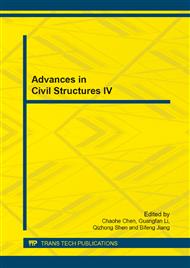[1]
Hidalgo P A. Ledezma C A. and Jordan R. M. Seismic behavior of squat reinforced concrete shear walls. Earthquake Spectra, EERI, Vol. 18, No. 2, pp.287-308.
DOI: 10.1193/1.1490353
Google Scholar
[2]
Barda F. Hanson J M. and Corley W G. Shear Strength of Low-Rise Walls with Boundary Elements. ACI Special Publications. Reinforced Concrete in Seismic Zones SP-53-8, 1977, pp.149-202.
Google Scholar
[3]
Wood S. Shear Strength of Low-Rise Reinforced Concrete Walls. ACI Structural Journal Vol. 87, No. 1, January-February 1990, pp.99-107.
DOI: 10.14359/2951
Google Scholar
[4]
ACI Committee 318. Building Code Requirements for Reinforced Concrete (ACI 318- 2008). American Concrete Institute. Farmington Hill. Michigan (2008).
DOI: 10.14359/12026
Google Scholar
[5]
Concrete Design Committee P 3101. 2006. Concrete Structures Standard, Part 1−The Design of Concrete Structures, Standards New Zealand, New Zealand, Wellington (2006).
Google Scholar
[6]
Cardenas AE. Russell HG. Corley WG. Strength of low-rise structural walls. ACI. SP 63-10. 1980. p.22141.
Google Scholar
[7]
Lefas DI. Kotsovos DM. Ambraseys NN. Behavior of reinforced concrete structural walls: deformation characteristics, and failure mechanism. ACI Struct J 1990; 87(1): 23-31.
DOI: 10.14359/2911
Google Scholar
[8]
Alexander, C. M., Heidebrecht, A. C., and Tso, W. K., 1973, Cyclic Load Tests on Shear Wall Panels, Proceedings, Fifth World Conference on Earthquake Engineering, Rome, Italy, pp.1116-1119.
Google Scholar
[9]
Xie L. and Xiao Y. Study on Retrofit of Existing Squat Concrete Shear Walls. Report No. USC-SERP 2000-5, Department of Civil Engineering, University of Southern California, Los Angeles, CA, 111 pp.
Google Scholar
[10]
Massone L M. RC Wall Shear-Flexure Interaction: Analytical and Experimental Responses. PhD Dissertation, Department of Civil and Environmental Engineering, University of California, Los Angeles, CA 2006, 398 pp.
Google Scholar
[11]
Zhang L X B. and Hsu T T C. "Behavior and Analysis of 100 MPa Concrete Membrane Elements. Journal of Structural Engineering, ASCE, Vol. 124, No. 1, pp.24-34.
Google Scholar
[12]
Wiradinata S. Behavior of Squat Walls Subjected to Load Reversals. MS Thesis, Department of Civil Engineering, University of Toronto, Toronto, ON, Canada, 1985 171 pp.
Google Scholar
[13]
Pilette F C. Behavior of Earthquake Resistant Squat Shear Walls. MS Thesis, Department of Civil Engineering, University of Ottawa, Ottawa, ON, Canada, 1987 177 pp.
Google Scholar
[14]
Mohammadi-Doostdar H. Behavior and Design of Earthquake Resistant Low Rise Shear Walls. Department of Civil Engineering, University of Ottawa, Ottawa, ON, Canada. 1994 234 pp.
Google Scholar
[15]
Greifenhagen C, Lestuzzi P. Static cyclic test on lightly reinforced concrete shear walls. EngStruct 2005; 27: 1703-12.
DOI: 10.1016/j.engstruct.2005.06.008
Google Scholar
[16]
Hirosawa. M. Past Experimental Results on Reinforced Concrete Shear Walls and Analysis on Them, KenchikuKenkyu Shiryo, Building Research Institute, Ministry of Construction, Tokyo, Japan, 1975 No. 6. 277 pp.
Google Scholar
[17]
Yoshizaki S. et al. Behavior of Shear Wall Using Various Yield Strength of Rebar, Part 1: An Experimental Study. Proceedings. Tenth International Conference on Structural Mechanics in Reactor Technology, H09/01, Anaheim, CA1989.
Google Scholar
[18]
Paulay T. Priestley M J N. and Synge A J. Ductility in Earthquake Resisting Squat Shea rwalls. ACI Journal. 1982 Vol. 79, No. 4, Jul. -Aug., pp.257-269.
Google Scholar
[19]
Huang C C and Sheu M S. Experimental and theoretical study on aseismic behaviors of low-rise RC shear walls. Proceedings, Ninth World Conference on Earthquake Engineering, Tokyo-Kyoto, Japan, 1988 p.6/35-6/40.
Google Scholar
[20]
Hidalgo P A. Jordan R. and Ledezma C. A. Experimental Study of Reinforced Concrete Walls under Shear Failure. Proceedings, Sixth U.S. National Conference on Earthquake Engineering, Seattle, WA (1998).
Google Scholar
[21]
Salonikios TN, Kappos AJ, Tegos IA, Penelis GG. Cyclic load behavior of low-slenderness reinforced concrete walls: failure modes, strength and deformation analysis, and design implications. ACI Structure J 2000; 97(1): 132-41.
DOI: 10.14359/842
Google Scholar


